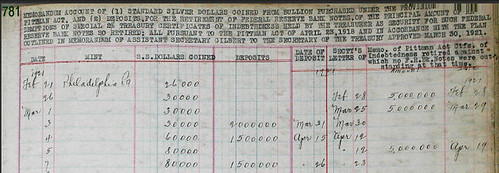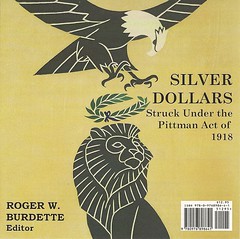
PREV ARTICLE
NEXT ARTICLE
FULL ISSUE
PREV FULL ISSUE
BOOK REVIEW: SILVER DOLLARS STRUCK UNDER THE PITTMAN ACT OF 1918
In his Introduction, Burdette notes that: This digital information storage device includes photographic images of the Treasurer‘s journal of silver dollars produced using silver purchased under authority of the Pittman Silver Purchase Act of 1918. Original documents are located in the National Archives and Records Administration facilities in College Park, Maryland, and Philadelphia, Pennsylvania. The author's purpose was to make available to researchers and other interested parties original documentary information that would otherwise only be available by traveling to the NARA facilities. Burdette opens the book with a new nine-page essay titled "The Pittman Silver Purchase Act 1918". Here are a couple excerpts. Huge subsidies created by the Bland-Allison Act of 1878 and the Sherman Silver Purchase Act of 1890 led to production of millions of largely unwanted silver dollars. The Sherman Act was also a direct contributor to economic depression by requiring purchase of 4,500,000 ounces of silver bullion per month with payment made in notes redeemable in either gold or silver. This created ideal conditions for speculators who soon threatened the Treasury's gold reserves. Mine owners and speculators grew rich, but the country as a whole suffered. Passage of the Gold Standard Act in 1900, and the return to prosperity following the Panic of 1893 shattered the influence of western silver-state Senators. It took events in remote India to temporarily resurrect silver production in the United States. The only immediate source of silver was in United States Mint vaults – 490 million silver dollars. I was completely unaware of the Indian connection. It's a fascinating backdrop to the legislation. The events make for interesting reading.
The mint's silver dollars barely circulated as money. Most were held as backing for silver certificates. While the coins could provide the British with all the silver they needed, only Congress had the authority to permit them to be melted. In January 1918, it appears that Pittman and Baker began planting exploratory information with newspapers about the need to melt some of the nation's silver dollars. Senator Pittman and director Baker were given complete responsibility for the emergency silver legislation and conferred with other silver producing state senators and representatives. All were clearly motivated by patriotism and their desire to help the war effort, but they also saw an opportunity to aid mining in their home states. Mint Director Baker and Assistant Treasury Secretary Leffingwell did not wait for Congress to act. During March and early April, silver dollars were consolidated at the Philadelphia Mint. Unusually large quantities of silver bars were also shipped to India with no public announcement. It is also likely that the breakup and rolling of dollars began well before the Pittman Act was signed. On April 30, 29,745,651 silver dollars were reported demonetized – meaning they were melted or rolled out. Approximately 26 million of these came from the New York Federal Reserve Bank vaults, and were taken to the New York Assay Office for melting.
Initially, this "Pittman silver" as it was commonly called, was used for subsidiary coin production. However, near the end of the year it became evident that economic demand for coins was declining, and a way had to be found to use the silver while minimizing storage costs. The silver was paid for by issuing government certificates (bonds) bearing interest at 2% per year. Eventually, this domestic silver produced 86,730,000 1921-dated Morgan dollars and 183,502,722 Peace dollars (from 1921 to 1928). This exactly matched the quantity melted during 1918-1919. I'll stop there with the quotes, but the essay goes on to discuss George Morgan's efforts to produce dies for the new coins. Even though most of the coins went "directly from coinage press to storage vault", Burdette notes that "Artists and coin collectors saw the resumption of silver dollar production as an opportunity to create a new design" which ultimately resulted in the creation of the Peace Dollar. So THAT'S where those anachronistic 1921 Morgans came from. Burdette's essay is great background reading for any U.S. numismatist, providing insight into not only the reasons for minting these coins, but also why & how so many others were destroyed (and that goes for Silver Certificates, which were also both destroyed and created as an indirect result of the Act). As for the raw Treasurer‘s journal entries, they provide detailed first-hand evidence of the daily dollar coining activities at the various Mints. Interesting for those who know what they're looking at and what they're looking for. Others may have a harder time extracting value. But as Burdette noted in the press release for the book, ... only a handful of researchers have ever examined these important records since their re-discovery four years ago. Now collectors and silver dollars specialists can examine documents that were completely unknown to van Allen and Mallis, Breen, Taxay, Bowers and others. This is the first and only published edition of these invaluable historic resources.

As a bonus, the full text of the Pittman Act of 1918 is included along with a Federal Reserve Bank discussion of silver purchases since the Bland-Allison Act of 1878. In summary, although the subject matter may not be everyone's cup of tea, this CD-ROM book is a trove of data for any collector or researcher interested in this curious era of U.S. Numismatics. Silver Dollars Struck Under the Pittman Act of 1918 is available for an introductory price of $8.95 (regularly $12.95) postpaid from the publisher, Seneca Mill Press LLC. Discount orders accepted until February 22.
To order send check or money order for $8.95 to: Seneca Mill Press LLC, PO Box 1423, Great Falls, VA 22066.
The Numismatic Bibliomania Society is a non-profit organization promoting numismatic literature. See our web site at coinbooks.org. To submit items for publication in The E-Sylum, write to the Editor at this address: whomren@gmail.com To subscribe go to: https://my.binhost.com/lists/listinfo/esylum All Rights Reserved. NBS Home Page Contact the NBS webmaster 
|
